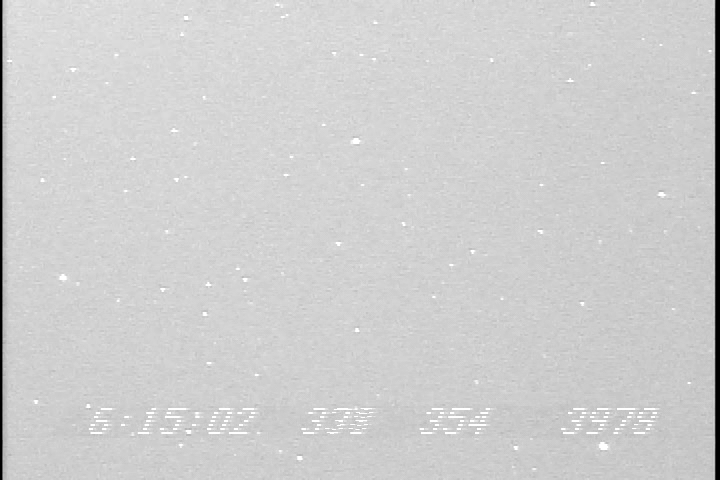
 Copyright © Michael Richmond.
This work is licensed under a Creative Commons License.
Copyright © Michael Richmond.
This work is licensed under a Creative Commons License.
Table of contents:
On Dec 31, 2005, Michael Vasseur watched to see if the Kuiper-belt object (20000) Varuna would occult the star 2UCAC 40675770. Maps of the event are at Steve Preston's occultation predictions site. This was a very challenging event, because the target star was very faint (around mag 15), the occulting body was completely invisible (near mag 20), and the uncertainty in path location was pretty big.
Michael's location for observing this event was at the Galaxy Blues Observatory, IAU code H89:
His equipment included
Michael set up his camera so that it co-added 128 fields into a single summed image; since each field is 1/60 of a second, each summed image covers about 2.1 seconds. He sent the video through a KIWI OSD unit, which placed a time signal on each frame of the video. That means that the resulting movie shows
I stupidly didn't read his message describing this automatic co-adding carefully, and so wasted a day or two chopping the movie into individual 1/30-second frames ... which turned out to have exactly the same stellar information as their neighbors. Silly me.
Michael made a copy of his movie available on his web site. The movie is in DVR-MS format, which is a version of MPEG-12, I believe. It's a bit harder than usual to break a movie of this format into individual images, but I managed to figure out how to modify my software to do so.
First, get the latest version of MPlayer. Next, grab a copy of codecs.conf file and edit it to add one line to the stanza for "videocodec mpeg12", as shown below.videocodec mpeg12 info "MPEG-1 or 2 (libmpeg2)" comment "with postprocessing" status working format 0x10000001 ; MPEG-1 format 0x10000002 ; MPEG-2 ; added this line to play dvr-ms Digital Video files ; as instructed on MPlayer E-mail archives format 0x20525644 ; dvr-ms driver libmpeg2 ; dll "libmpeg2" out YV12,I420,IYUV out 422PThen, invoke MPlayer with the following command-line options to play the movie "file.dvr-ms".mplayer -demuxer 35 -codecs-file /etc/mplayer/codecs.conf file.dvs-ms
Each frame of the movie is 720x480 pixels. Although the movie file is 17948 frames and 220 MBytes in size, there are really only 280 distinct images of the sky and stars (1 out of every 64 frames). The entire dataset is much more manageable once one has extracted these 280 frames. Below is an example, frame number 75 out of the 17948 frames in the big movie.

Each pixel in the image can hold one of 256 greyscale values (called "counts" from here on). The background sky was high, at about 200 counts; that left only about 56 counts for all the stellar data before a star would saturate. Setting the gain parameters in this fashion was probably necessary to detect the very faint target star, but it leaves very little dynamic range for measurement.
I processed this movie file in the following manner:
In addition to the target star, there are several other stars visible in the field. Here's a stretched version of frame 75.
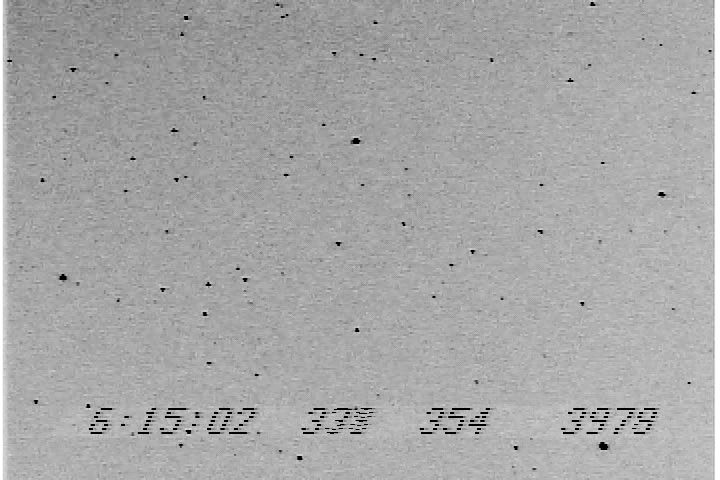
Here's the same image with a couple of labels. Note how faint the target is, and how close it is to a much brighter star.
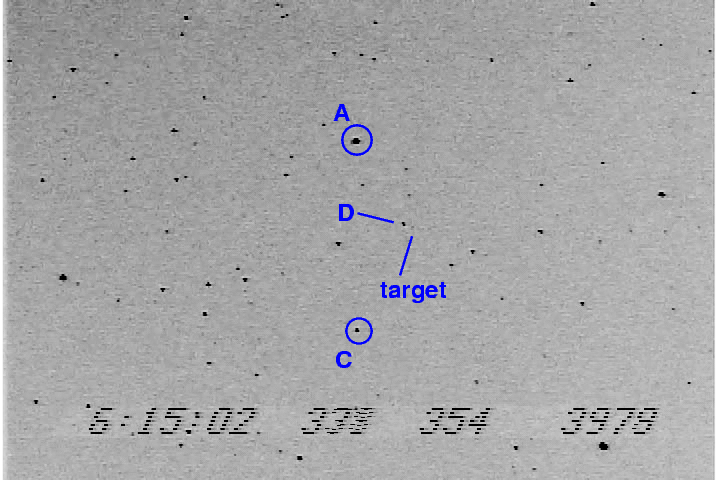
And here's a chart from Aladin with the stars of interest labelled.

star UCAC2 ID UCAC2 mag
----------------------------------------------------
A 40675796 9.9
D 40675774 13.8
target 40675770 15.5
-----------------------------------------------------
Most of the stars were saturated in the 8-bit FITS images which I extracted from the movie file. The FWHM was hard to measure, but was around 3 pixels for stars like C and D.
For each of the 280 frames, I
After looking at the resulting light curves, I decided that the smaller the synthetic aperture, the better. I chose a radius of 2 pixels for the data shown below.
Here are quick views of the results.
The entire light curve for the target and several other stars.
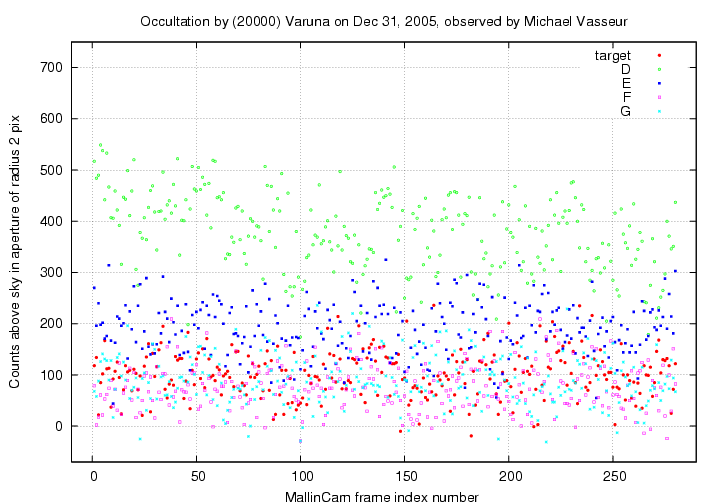
Here are the curves for the target and nearby star D only.
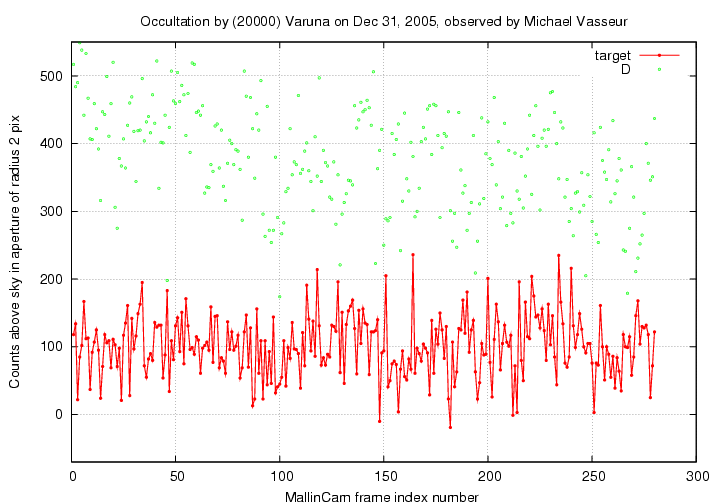
The target star does not appear to show any clear signal of an occultation. It bounces up and down a lot on short timescales, but so do the other faint stars "F" and "G".
I then performed ensemble photometry on the group of stars D, E, F, G, and target, using my ensemble photometry package. The idea is to remove any systematic shifts in the overall brightness of all the stars from frame to frame; if, for example, a cloud covered the field for three frames, it might make all the stars appear 0.20 mag fainter. Or if a strong wind shook the telescope for several seconds, it might blur the images, again making all the stars fainter by a similar fraction.
The bright stars D and E dominate the ensemble solution. Here are the amounts by which each frame had to be shifted up or down, in magnitude units, to make all the stars best match their average brightness. The vertical scale has an arbitrary zeropoint.

You can see that the average brightness of all the stars varied by up to about 1 magnitude at most; that corresponds to a factor of about 2.5 in brightness. I think that the brief excursions to fainter brightness were caused by gusts of wind shaking the telescope, as Michael Vasseur mentioned in his messages.
After removing those systematic shifts in brightness, we obtain the remaining light curves of each object. In the graph below, I have used magnitude units and shifted several of the stars vertically for clarity.

We are looking for a time during which the target star becomes fainter or disappears, but none of the other stars becomes fainter. There isn't much evidence for such an event. Maybe the best candidate time is around frames 80 to 100, which correspond to times UT 06:17:51 to 06:18:33.
You can grab the data in a multi-column ASCII text file below. The columns are
col quantity
------------------------------
1 frame index
2,3 flux of target star in 2-pixel-radius aperture,
and estimate of uncertainty in that flux
4,5 ditto 2.5-pixel aperture
6,7 ditto 3-pixel aperture
8,9 ditto 4-pixel aperture
10,11 ditto 5-pixel aperture
12,13 flux of star D in 2-pixel aperture,
and estimate of uncertainty in that flux
14,15 ditto 2.5-pixel aperture
16,17 ditto 3-pixel aperture
18,19 ditto 4-pixel aperture
20,21 ditto 5-pixel aperture
22,23 flux of star E in 2-pixel aperture,
and estimate of uncertainty in that flux
24,25 ditto 2.5-pixel aperture
26,27 ditto 3-pixel aperture
28,29 ditto 4-pixel aperture
30,31 ditto 5-pixel aperture
32,33 flux of star F in 2-pixel aperture,
and estimate of uncertainty in that flux
34,35 ditto 2.5-pixel aperture
36,37 ditto 3-pixel aperture
38,39 ditto 4-pixel aperture
40,41 ditto 5-pixel aperture
42,43 flux of star G in 2-pixel aperture,
and estimate of uncertainty in that flux
44,45 ditto 2.5-pixel aperture
46,47 ditto 3-pixel aperture
48,49 ditto 4-pixel aperture
50,51 ditto 5-pixel aperture
Because the photometry of the original 2.1-second exposures was so low in signal-to-noise ratio, I decided to try co-adding several consecutive frames. Michael Vasseur also suggested doing this in one of his messages. I simply added together each set of N=5 consecutive frames, reducing the 280 original frames down to 56 coadded images. I did not attempt to register the stars in each set of 5 images before adding them together (well, actually I did try that, but it turned out to be very difficult, so I gave up).
I then performed exactly the same sort of aperture photometry on this set of 56 images as I did for the original dataset. The results are shown below.
Here are the measurements, in linear units, for stars in the coadded images.
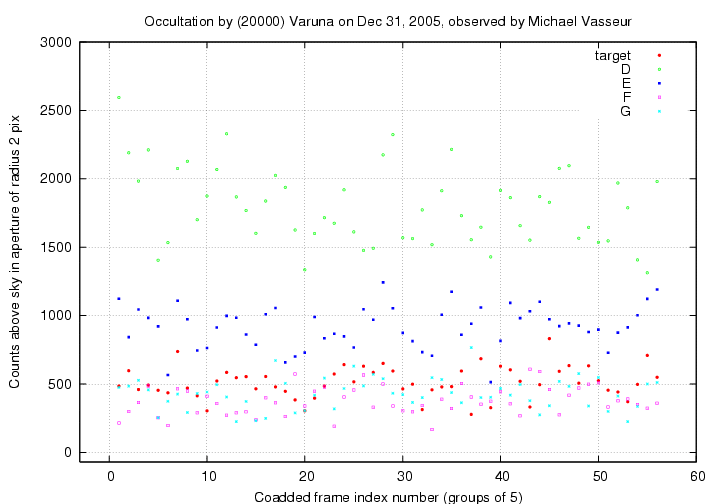
Here are just the target and the nearby star D:
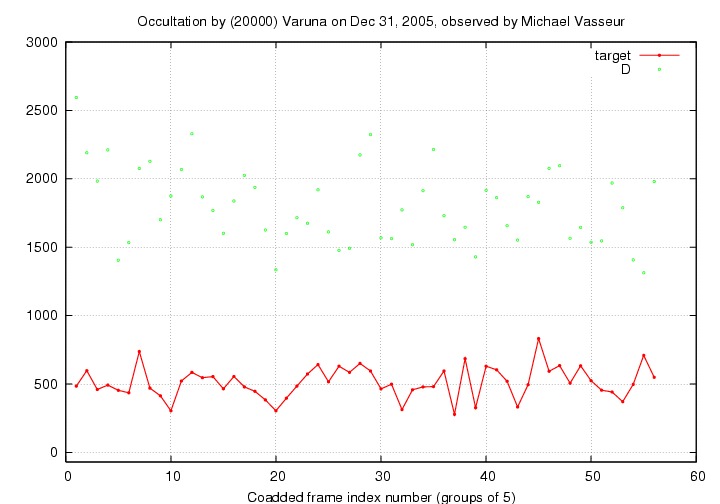
Again, it appears that the target star may become a bit fainter during the same period as before (original frames 80 to 100, coadded frames 16 to 20), but it doesn't look like a real occultation.
I again performed ensemble analysis on photometry from the coadded images. The systematic shifts are a bit smaller than they were before, reaching only about 0.6 mag peak-to-peak instead of roughly 1.0 mag peak-to-peak.
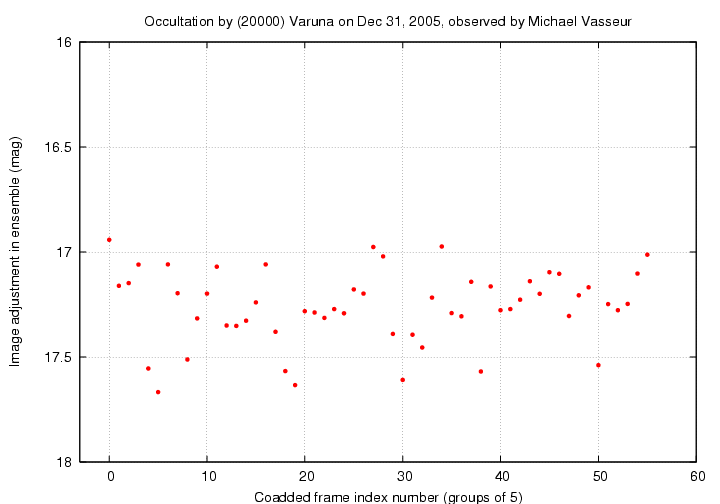
And here are the ensemble light curves from coadded images:
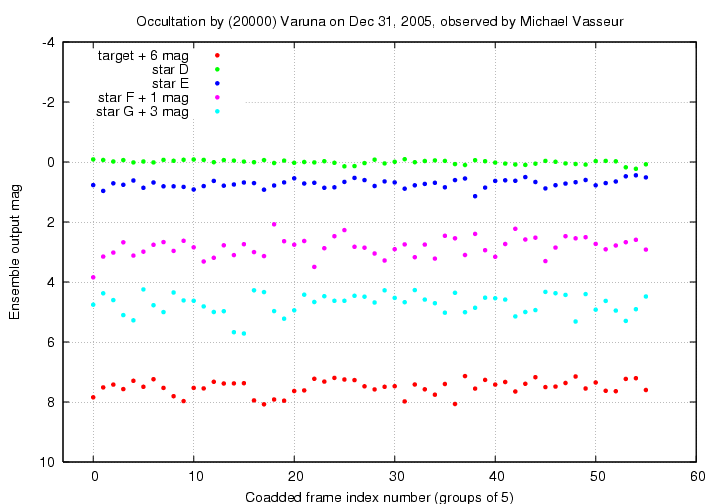
The case for an occultation looks even weaker to my eyes in this coadded dataset. But feel free to analyze the numbers if you wish.
 Copyright © Michael Richmond.
This work is licensed under a Creative Commons License.
Copyright © Michael Richmond.
This work is licensed under a Creative Commons License.